- Art Home
- Exhibitions
-
Explore the Collection
- Explore the Collection Home
- African Art
- American Paintings, Sculpture and Drawings
- Contemporary
- Decorative Arts and Design
- East Asian Art
- European Paintings, Sculpture and Drawings
- Fashion Arts and Textiles
- Musical Instruments
- Indigenous American Art
- Photography
- Prints
- South Asian Art, Islamic Art and Antiquities
- Conservation
- Meet the Curators
- Digital Resources
- Events & Programs Home
- Calendar
- Accessibility
- Adults
-
Families & Teens
- Families & Teens Home
- 10x10 Teen Art Expo
- Art on the Rise
- Art Together: Art Making for Families with Children Ages 3–5
- Baby Tours
- Boy Scouts / Girl Scouts
- CAM Kids Day
- Choose Your Own Gallery Adventure
- Family Storytime and Gallery Walk
- Family Studio: Art Making for Families with Children Ages 6–12
- REC Reads
- Rosenthal Education Center (REC)
- See Play Learn Kits
- Summer Camp
- Teachers
- Community Outreach
- Fundraisers
- Plan Your Own Event

- Art Home
- Exhibitions
-
Explore the Collection
- Explore the Collection Home
- African Art
- American Paintings, Sculpture and Drawings
- Contemporary
- Decorative Arts and Design
- East Asian Art
- European Paintings, Sculpture and Drawings
- Fashion Arts and Textiles
- Musical Instruments
- Indigenous American Art
- Photography
- Prints
- South Asian Art, Islamic Art and Antiquities
- Conservation
- Meet the Curators
- Digital Resources
- Events & Programs Home
- Calendar
- Accessibility
- Adults
-
Families & Teens
- Families & Teens Home
- 10x10 Teen Art Expo
- Art on the Rise
- Art Together: Art Making for Families with Children Ages 3–5
- Baby Tours
- Boy Scouts / Girl Scouts
- CAM Kids Day
- Choose Your Own Gallery Adventure
- Family Storytime and Gallery Walk
- Family Studio: Art Making for Families with Children Ages 6–12
- REC Reads
- Rosenthal Education Center (REC)
- See Play Learn Kits
- Summer Camp
- Teachers
- Community Outreach
- Fundraisers
- Plan Your Own Event
Blog
Blog
- Home
- Plan Your Visit
-
Art
- Art Home
- Exhibitions
-
Explore the Collection
- Explore the Collection Home
- African Art
- American Paintings, Sculpture and Drawings
- Contemporary
- Decorative Arts and Design
- East Asian Art
- European Paintings, Sculpture and Drawings
- Fashion Arts and Textiles
- Musical Instruments
- Indigenous American Art
- Photography
- Prints
- South Asian Art, Islamic Art and Antiquities
- Conservation
- Meet the Curators
- Digital Resources
-
Events & Programs
- Events & Programs Home
- Calendar
- Accessibility
- Adults
-
Families & Teens
- Families & Teens Home
- 10x10 Teen Art Expo
- Art on the Rise
- Art Together: Art Making for Families with Children Ages 3–5
- Baby Tours
- Boy Scouts / Girl Scouts
- CAM Kids Day
- Choose Your Own Gallery Adventure
- Family Storytime and Gallery Walk
- Family Studio: Art Making for Families with Children Ages 6–12
- REC Reads
- Rosenthal Education Center (REC)
- See Play Learn Kits
- Summer Camp
- Teachers
- Community Outreach
- Fundraisers
- Plan Your Own Event
- Give & Join
- About
- Tickets
- Calendar
- Exhibitions
- Blog
- Shop
Celebrating Asian American Pacific Islander Heritage Month
by Cincinnati Art Museum
5/7/2021
Asian Art , Asian American Pacific Islander Art , Rookwood Pottery Company , Nam June Paik , Bukang Kim , Kitaro Shirayamadani
In honor of Asian American Pacific Islander (AAPI) Heritage Month this May, the Cincinnati Art Museum is continuing to recognize and appreciate the immense role Asian peoples and cultures have in our collection, and Asian Americans’ fundamental human right to the pursuit of life, liberty and happiness in Greater Cincinnati and across the world.
Enjoy these works by artists who identify as Asian American or Pacific Islander in the museum’s permanent collection.
Bukang Y. Kim (b. 1943)
Bukang Kim is a Korean-born American artist based in Cincinnati, Ohio. She received her early training at Seoul National University and, after coming to the United States in 1970, furthered her study at the University of Cincinnati. Her paintings and drawings have been widely exhibited in South Korea, Europe, and the United States. In 2014, the Cincinnati Art Museum hosted special exhibition Bukang Y. Kim: Journey, highlighting Kim’s artistic journey of over thirty years.
The path Kim has traveled in the development of her artistic style is long and inspirational. Her migration to the United States not only led to her to develop a new sensitivity to the arts and cultures of her Korean homeland, but also helped provide her with a completely new cultural identity, reshaping both her technical and spiritual artistic perspective. Memories from the past, such as the resounding ring of the temple bell in the mountains (Image 1), the ancient wood columns (Image 2), or the paper-mounted sliding doors in the traditional Korean house (Image 3), evoke not only strong emotions associated with her home country, but also a new interpretation of the Asian philosophies and cosmological concepts (the Daoist duality of the universe: yin/yang, sound/silence, solid/void, within/without, light/dark) so familiar to her. Her western-based training combined with her deep understanding of the Asian aesthetics and strong discipline in Asian calligraphy has helped her create a powerful and distinctive pictorial language all her own.
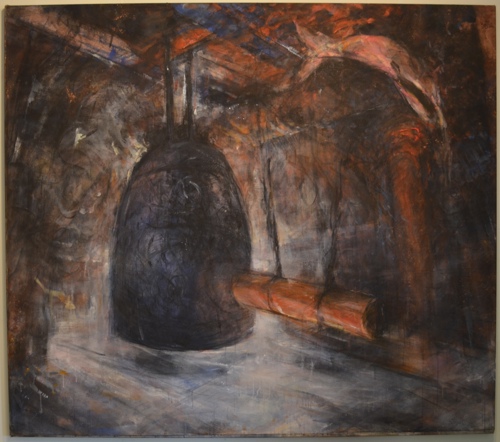
Image 1: Bukang Y. Kim, United States, The Bell, 1988, acrylic on canvas, 84 x 96 in. (213.4 x 243.8 cm), Gift of Bukang Yu Kim and Dr. Young Ghon Kim, 2019.291
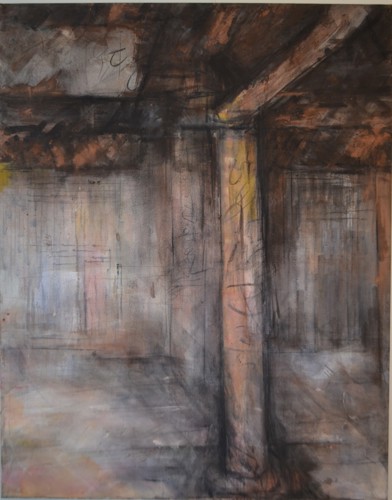
Image 2: Bukang Y. Kim, United States, Column, 1988, mixed media on canvas, 84 x 66 in. (213.4 x 167.6 cm), Gift of Bukang Yu Kim and Dr. Young Ghon Kim, and family, 2015.140
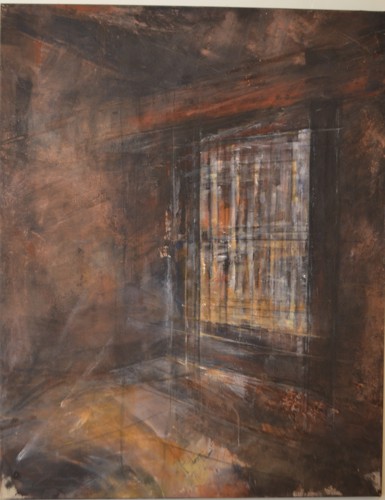
Image 3: Bukang Y. Kim, United States, Morning Calm, 1988, mixed media on canvas, 84 x 66 in. (213.4 x 167.6 cm), Gift of Bukang Yu Kim and Dr. Young Ghon Kim, and family, 2015.139
Nam June Paik (1932–2006)
When approached by the Cincinnati Art Museum to create a piece specific to Cincinnati, Nam June Paik suggested a video sculpture to honor Powel Crosley, Jr., the Cincinnati inventor and entrepreneur. Paik, who exhibited internationally, at that time assembled all his sculptures, including Powel Crosley, Jr., in a warehouse in the Cincinnati neighborhood of Over the Rhine.
The work consists of a variety of Crosley products: TV and radio cabinets, car hubcaps and handles, radios, freezer doors, and radio transmission tubes. The boxy-looking “portrait” is related to a family of human-looking robots that Paik created in 1986. In the Crosley sculpture, he used eight television monitors to project two different programs. These programs loop clips from a television profile of Crosley Paik intercut with popular imagery, which flash on the screens at a hypnotizing pace. In contrasting the antiquated Crosley parts with contemporary digital media, Paik made an oblique comment on technological evolution.
Crosley was born in Cincinnati in 1886. After working first in advertising and auto building, he brought the new technology of radio to millions through build-it-yourself kits. Crosley also founded radio station WLW and public television WCET, made the first car radio, built the first compact car, and owned the Cincinnati Red Stocking baseball team.
Paik, born in Korea, studied music and art history in Tokyo. In 1958 he met the composer John Cage, who became a lasting influence on him. In the 1960s Paik became fascinated with television and video. He exploited the medium to asset his belief that the human spirit is ascendant over technology, no matter how.
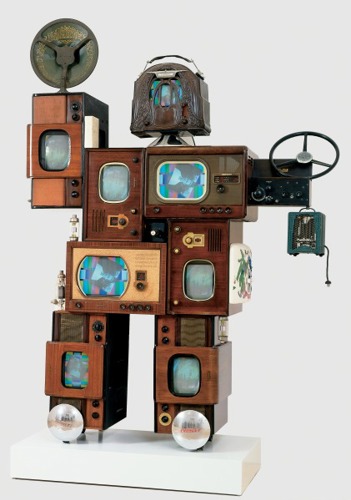
Powel Crosley, Jr., Nam June Paik (American, b.1932, d.2006), artist, 1992, Cincinnati/Ohio/United States, wood, plastic, paint, glass, custom electronics, parts from a variety of Crosley products that date from the 1920s through the early 1950s, eight CRT televisions, two DVD players, video, John J. Emery Endowment and The Edwin and Virginia Irwin Memorial, © Nam June Paik Estate, 1992.140
Kitaro Shirayamadani (1865–1948)
In 1895, the Rookwood Pottery Company began experiments to achieve the highly difficult technical feat of using the color black in its Iris glaze line. Their experiments succeeded, and in 1899 Rookwood launched the Black Iris glaze line, which featured natural-colored decorations, usually flora, on black backgrounds.
Japanese-born Kitaro Shirayamadani, Rookwood’s most accomplished decorator, designed and created this masterpiece in the pottery’s new line. It features birds flying above masterfully carved silver and copper water lilies, all against a black night sky. The complex technique of adding metallic decoration to clay via electrodeposit had been developed by Shirayamadani earlier that year, but Rookwood soon discontinued its application due to high production costs.
This vase, because of its date, its size, its use of the electrodeposited metal technique, its glaze line, its decorator and its quality, was almost certainly one of the works displayed at the Exposition Universelle of 1900 in Paris, where Rookwood received the grand prize–the fair’s highest honor.
Shirayamadani continued to work for Rookwood until his death in 1948.
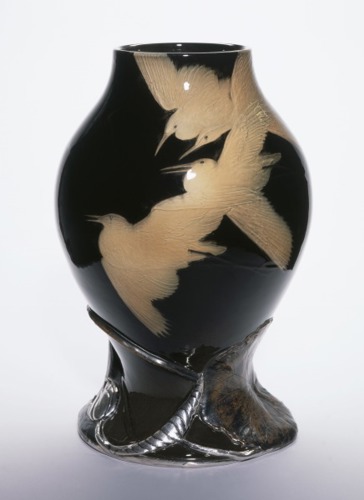
Vase, 1900, The Rookwood Pottery Company (American, est. 1880), Kitaro Shirayamadani (American, b. Japan, 1865–1948), decorator, stoneware, Black Iris glaze line with copper and silver electrodeposits, Museum Purchase: Lawrence Archer Wachs Fund and a generous gift from Judge and Mrs. Norman A. Murdock, 2004.68
Cincinnati, OH 45202
Toll Free: 1 (877) 472-4226
Museum Hours
Museum Shop
Terrace Café
Library
The Cincinnati Art Museum is supported by the generosity of tens of thousands of contributors to the ArtsWave Community Campaign, the region's primary source for arts funding.

Free general admission to the Cincinnati Art Museum is made possible by a gift from the Rosenthal Family Foundation. Exhibition pricing may vary. Parking at the Cincinnati Art Museum is free.
Generous support for our extended Thursday hours is provided by Art Bridges Foundation’s Access for All program.

General operating support provided by:



